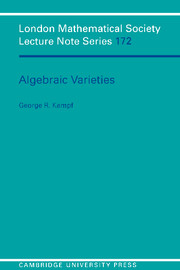Book contents
- Frontmatter
- Contents
- Introduction
- 1 Algebraic varieties: definition and existence
- 2 The preparation lemma and some consequences
- 3 Products; separated and complete varieties
- 4 Sheaves
- 5 Sheaves in algebraic geometry
- 6 Smooth varieties and morphisms
- 7 Curves
- 8 Cohomology and the Riemann–Roch theorem
- 9 General cohomology
- 10 Applications
- Appendix
- Bibliography
- Glossary of notation
- Index
- Frontmatter
- Contents
- Introduction
- 1 Algebraic varieties: definition and existence
- 2 The preparation lemma and some consequences
- 3 Products; separated and complete varieties
- 4 Sheaves
- 5 Sheaves in algebraic geometry
- 6 Smooth varieties and morphisms
- 7 Curves
- 8 Cohomology and the Riemann–Roch theorem
- 9 General cohomology
- 10 Applications
- Appendix
- Bibliography
- Glossary of notation
- Index
Summary
Algebraic geometry is a mixture of the ideas of two Mediterranean cultures. It is the superposition of the Arab science of the lightning calculation of the solutions of equations over the Greek art of position and shape. This tapestry was originally woven on European soil and is still being refined under the influence of international fashion. Algebraic geometry studies the delicate balance between the geometrically plausible and the algebraically possible. Whenever one side of this mathematical teeter-totter outweighs the other, one immediately loses interest and runs off in search of a more exciting amusement.
In this book we present from a modern point of view the basic theory of algebraic varieties and their coherent cohomology. The local part of the study includes dimension and smoothness. I have tried to keep the commutative algebra down to minimum while putting the geometry close to the algebra as part of the exposition.
The basic tools in algebraic geometry are sheaves and their cohomology. This material is presented from the beginning. I have included the basic discussion of curves to illustrate the theory.
To proceed further in algebraic geometry one needs to learn scheme language. This transition should be easy for the reader of this book. One needs only to drop the assumption that the structure sheaf consists of functions. In writing this book I missed having generic points of subvarieties and closed subschemes. But the main battle was to teach the reader to think globally in sheaf-theoretic language.
- Type
- Chapter
- Information
- Algebraic Varieties , pp. ix - xPublisher: Cambridge University PressPrint publication year: 1993

